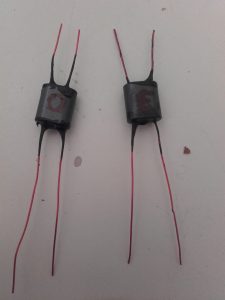July 09, 2021
Today I started working on the BalUn of beverage and BOG and on the termination of the “snake”.
First of all some documentation to refresh the basics, from the ON4UN book, and some notes on what I have planned.
I started preparing the transformer 450: 50 for the beverage and 200: 50 for the box.
Both transformers, tested on the instrument, give a SWR lower than 1.2: 1 from 1MHz to 12MHz and then progressively rise.
This result is up to the the type of ferrite used, in this case #73.

Once the two transformers were wound and tested in the laboratory, I fixed the coils with “liquid tape”.
To avoid confusion, I marked the two transformers:
- “O” – for BOG
- “E” – for Beverage
Now let’s work on the boxes, SO239 connector and GND and antenna wire terminals.
So .. what do we need ?
- cable lugs
- stainless steel screws, washers and bolts
- SO239 teflon connectors
… and few tools.
In a maximum of one hour of work, the beverage, bog and snake boxes are ready; for beverage and BOG the boxes will be placed on the power point, while for the “snake” the box will be placed at the termination and will contain the 4t+4t transformer to GND.
Now that the boxes are ready I can insert the transformers, weld them and isolate everything with “liquid tape”.
The transformers for beverage and bog are wound with 0.25mm enamelled copper rows while the 4t+4t transformer for the termination of the “snake” is wound with 0.5mm enamelled copper wire.
Initially I had thought of inserting a chocke (CMCC) in RG316 Teflon ccoax between the SO239 connector and the transformer but in the end I didn’t consider this step necessary, reducing the size of the box and the loss of the connections.
I don’t plan on using LNA preamps on beverages this season so insertion losses are an important factor to be considered.
From next season we should be able to live in the definitive property and I will have enough space there for a considerable number of beverages in various directions, at which point it may be reasonable to apply a preamp to each antenna as it is a definitive installation.










